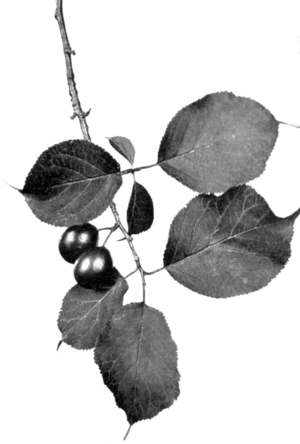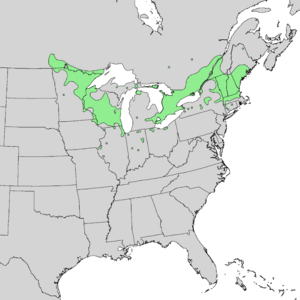Canada plum facts for kids
Quick facts for kids Canada plum |
|
|---|---|
 |
|
| Fruits and leaves | |
| Scientific classification | |
 |
|
| Natural range of Prunus nigra | |
| Synonyms | |
|
The Canada plum (also called Canadian plum or black plum) is a type of tree or shrub. Its scientific name is Prunus nigra. It grows naturally in eastern North America. You can find it from Nova Scotia in Canada, west to Minnesota and southeastern Manitoba, and south to states like Connecticut, Illinois, and Iowa.
This tree used to grow in Ohio but is now gone from there. You can also find small groups of Canada plums along rivers in Saskatchewan and Alberta. Some grow near Lake Timiskaming in northern Ontario and along the Maine-New Brunswick border. However, these trees are sometimes cut down because they can host tiny insects called aphids, which can harm local potato crops.
Contents
What Does the Canada Plum Look Like?
The Canada plum is a deciduous plant, meaning it loses its leaves in the fall. It can be a shrub or a small tree. It usually grows up to 10 meters (about 33 feet) tall. Its trunk can be up to 25 centimeters (about 10 inches) wide. The tree has many stiff, strong branches that form a thick crown.
Bark and Branches
The bark of the Canada plum is gray-brown. As the tree gets older, the outer layers of bark peel off in thick pieces. When branches are new, they are bright green. Later, they turn dark brown with a reddish tint and can have thorns. The winter buds are chestnut brown and pointed, growing up to 8 millimeters (about 0.3 inches) long.
Leaves
The leaves grow in an alternating pattern along the branch. They are simple, meaning each leaf is one piece. Their shape is like a long oval, about 5 to 12 centimeters (2 to 5 inches) long and 3 to 7 centimeters (1 to 3 inches) wide. The edges of the leaves have small, rounded teeth. The leaves come out of the bud rolled up and are a bit fuzzy and reddish. When fully grown, they become smooth and bright green on top, and lighter green underneath.
Flowers
The flowers of the Canada plum are about 15 to 25 millimeters (0.6 to 1 inch) wide. They have five rounded petals that start white and then fade to a light pink color. The edges of the petals are often slightly jagged. These flowers are a little bit fragrant. They grow in small clusters of three or four flowers. They appear in mid to late spring, even before the leaves fully open.
Fruit
The fruit is an oval-shaped drupe, which means it has a fleshy outer part and a hard pit inside. It is about 25 to 30 millimeters (1 to 1.2 inches) long. The skin is tough, thick, and orange-red. The inside flesh is yellow and sticks to the pit. The fruit ripens in late summer or early autumn. Canada plums grow best in rich, wet soil found near rivers.
Similar Trees
The Canada plum can sometimes be mistaken for a similar tree called Prunus americana. The easiest way to tell them apart is by looking at their leaves. Canada plum leaves have blunt, gland-tipped teeth on their edges. P. americana leaves have sharp teeth without glands.
Plum Pockets Disease
Sometimes, a type of fungus called Taphrina can attack Canada plums. When this happens, the young fruits swell up, often becoming much larger than normal plums. They become hollow and leathery, looking pale green. These "plum pockets" can even stay on the tree through winter. This disease makes it harder for new plum trees to grow.
How People Use Canada Plums
The fruit of the Canada plum is a bit sour, and its flesh sticks to the pit. It is very juicy. You can eat it fresh when it's fully ripe. People also cook it to make pies, preserves, and jellies.
Historical Uses
Long ago, indigenous peoples in North America would dry these plums. They were a popular food to eat during the winter. The French explorer Jacques Cartier wrote in his journal that the St. Lawrence Iroquoians gave him dried Canada plums during his first trip to Canada. Early settlers in the western U.S. and Canada also used these wild plums for dried fruit. This was made famous in the book On the Banks of Plum Creek by Laura Ingalls Wilder, which is part of her Little House on the Prairie series.
New Varieties
The Canada plum is one of the few fruit trees that grows naturally in the upper Midwest of the U.S. and the prairie provinces of Canada. It can survive very cold winters there. In the 1800s, people started trying to grow better kinds of these plums. Some well-known types still grown today are "Assiniboine" and "Cheney."
The Canada plum has the same number of chromosomes as the cultivated Japanese plum (Prunus salicina). This means they can easily cross-pollinate and create new hybrid trees. In the 1900s, people bred new hybrid varieties that mixed the good qualities of Japanese plums with the hardiness of wild Canada plums. Examples include "Pembina," "Superior," and "Patterson Pride."
Wood Uses
The wood of the Canada plum is a bright red-brown color. It is heavy, hard, strong, and has a tight grain. Its density is about 0.6918. When the wood is injured, it turns an attractive red color. Woodturners, who shape wood on a lathe, often look for logs from trees that have been intentionally wounded because of this beautiful red color.
Images for kids
See also
 In Spanish: Prunus nigra para niños
In Spanish: Prunus nigra para niños

